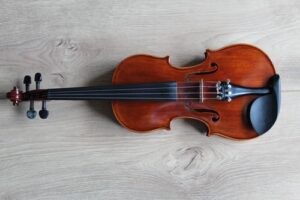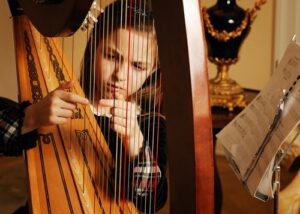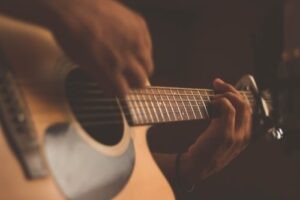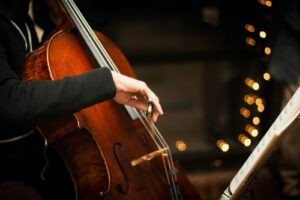Learning a musical instrument is a dream for many, and mastering one to create beautiful music is an impressive accomplishment. At LEARNS.EDU.VN, we understand the challenges involved in learning musical instruments, particularly those known for their difficulty, and we aim to provide resources and strategies to overcome them. Explore with us as we analyze the complexity of musical instruments and provide insights to succeed in your musical journey. Discover the difficulty levels and how to get started with instruments that require precision, coordination, and dedication.
1. Why Is Identifying The Hardest Instrument Important?
Understanding which instruments are the most challenging can help aspiring musicians set realistic goals, prepare for potential difficulties, and choose instruments that align with their capabilities and dedication levels. Identifying the factors contributing to an instrument’s difficulty can help learners to approach their practice more strategically and effectively.
1.1. Setting Realistic Expectations
Knowing that certain instruments require more time and effort allows learners to avoid discouragement and maintain motivation. Aspiring musicians can set achievable short-term goals that build toward long-term mastery, creating a sense of progress and accomplishment along the way.
1.2. Strategic Preparation
Identifying potential difficulties allows learners to prepare by acquiring necessary resources, such as specialized instruction, practice aids, and support networks. For example, a student tackling the violin might invest in a high-quality shoulder rest, a reliable tuner, and a mentor who can offer personalized guidance.
1.3. Informed Instrument Selection
Understanding the difficulty levels of different instruments allows learners to make informed decisions based on their aptitude, interests, and available resources. Someone with limited time for practice might choose a less demanding instrument initially, while someone with a strong passion for a particular sound might be willing to tackle a more challenging one.
2. Factors Determining the Difficulty of Learning an Instrument
Several factors contribute to the difficulty of learning a musical instrument. These can range from physical demands and technical precision to theoretical understanding and mental focus.
2.1. Physical Demands
Some instruments require significant physical strength, dexterity, and coordination. For example, playing the tuba or double bass demands considerable lung capacity and arm strength, while mastering the violin or harp requires fine motor skills and precise hand-eye coordination.
2.2. Technical Precision
Instruments like the violin, French horn, and oboe require a high degree of technical precision to produce accurate pitch and tone. These instruments often lack visual aids like frets or keys, relying instead on the musician’s ear and muscle memory.
2.3. Theoretical Understanding
Understanding music theory, including scales, chords, harmony, and rhythm, is crucial for mastering any instrument. However, some instruments, such as the piano and organ, require a more comprehensive understanding of music theory due to their polyphonic nature and complex arrangements.
2.4. Coordination and Multitasking
Certain instruments demand a high level of coordination and multitasking. For example, playing the drums involves coordinating all four limbs to maintain complex rhythms, while playing the organ requires simultaneous coordination of hands, feet, and eyes.
2.5. Embouchure and Breath Control
Wind instruments like the French horn, oboe, and bagpipes require precise embouchure (mouth position) and breath control to produce a consistent and pleasing sound. These skills can take years to develop and refine.
2.6. Initial Investment and Maintenance
The cost of acquiring and maintaining an instrument can also be a barrier to entry. Instruments like the harp, grand piano, and high-quality string instruments can be expensive, and their upkeep may require specialized skills and resources.
3. Top 10 Hardest Instruments to Learn
Based on various factors, including physical demands, technical precision, and theoretical understanding, here are ten of the most challenging instruments to master.
3.1. Violin
The violin is widely regarded as one of the most difficult instruments to learn. Its fretless fingerboard requires precise finger placement, relying solely on muscle memory and a keen ear. Additionally, producing a pleasing sound requires mastering complex bowing techniques, pressure, and speed.
Challenges:
- Fretless Fingerboard: Precise finger placement is essential for accurate pitch.
- Bowing Technique: Requires coordination, pressure, and speed for a pleasing sound.
- Sound Quality: Producing a good sound requires constant adjustments and practice.
3.2. French Horn
The French horn demands exceptional breath control, embouchure, and precise finger placement. The instrument’s complex tubing and narrow mouthpiece make it difficult to produce consistent pitch, and the close proximity of notes requires a highly refined ear.
Challenges:
- Breath Control: Maintaining consistent airflow is essential for tone and pitch.
- Embouchure: Precise mouth position is needed for accurate sound production.
- Finger Placement: The close proximity of notes requires a keen ear and fine motor skills.
3.3. Organ
The organ requires simultaneous coordination of hands, feet, and eyes. Playing complex pieces involves managing multiple keyboards, foot pedals, and stops, demanding a comprehensive understanding of music theory and advanced multitasking skills.
Challenges:
- Coordination: Requires simultaneous use of hands, feet, and eyes.
- Music Theory: A comprehensive understanding of music theory is essential.
- Multitasking: Managing multiple keyboards, pedals, and stops is highly demanding.
3.4. Bagpipes
The bagpipes require continuous airflow while maintaining consistent pressure on the bag. The complex finger positions and unique fingering techniques demand significant practice and dedication. Additionally, the instrument’s loud and distinctive sound can be challenging for beginners and those nearby.
Challenges:
- Continuous Airflow: Maintaining constant airflow is crucial for sound production.
- Bag Pressure: Consistent pressure on the bag is needed for steady tone.
- Fingering Techniques: Complex finger positions require dedicated practice.
3.5. Accordion
The accordion requires coordinated movement of both hands while managing bellows pressure and selecting appropriate buttons or keys. The instrument’s weight and complexity can be physically demanding, and mastering its unique sound requires a refined sense of musicality.
Challenges:
- Coordination: Requires coordinated movement of both hands.
- Bellows Pressure: Maintaining consistent bellows pressure is essential.
- Physical Demand: The instrument’s weight and complexity can be physically taxing.
3.6. Oboe
The oboe demands precise embouchure, breath control, and fingering techniques. The instrument’s double reed is sensitive and requires careful adjustment, and producing a consistent and pleasing sound requires significant practice and refinement.
Challenges:
- Embouchure: Precise mouth position is crucial for sound production.
- Breath Control: Consistent airflow is essential for tone and pitch.
- Double Reed: Requires careful adjustment and maintenance.
3.7. Harp
The harp has numerous strings, each requiring precise plucking and coordination. The instrument’s size and complexity can be physically demanding, and mastering its intricate sound requires a refined musical ear.
Challenges:
- Number of Strings: The harp can have up to 47 strings, requiring precision.
- Coordination: Precise plucking and coordination are essential.
- Physical Demand: The instrument’s size and complexity can be physically taxing.
3.8. Guitar
While the guitar is often seen as accessible, mastering it requires significant finger strength, coordination, and knowledge of music theory. Transitioning from individual notes to chords can be challenging, and learning to read guitar tablature takes time and effort.
Challenges:
- Finger Strength: Developing enough finger strength for chords is necessary.
- Coordination: Smooth transitions between chords require coordination.
- Guitar Tablature: Learning to read guitar tablature can be challenging.
3.9. Piano
While starting on the piano is relatively simple, mastering it requires years of dedicated practice. Achieving concert-level proficiency demands a deep understanding of music theory, exceptional hand independence, and the ability to interpret complex musical scores.
Challenges:
- Music Theory: A deep understanding of music theory is essential.
- Hand Independence: Developing independence between hands is crucial.
- Complex Scores: Interpreting complex musical scores requires advanced skills.
3.10. Cello
Similar to the violin, the cello requires precise finger placement on a fretless fingerboard. The instrument’s larger size and string tension can be physically demanding, and mastering bowing techniques requires significant practice and coordination.
Challenges:
- Fretless Fingerboard: Precise finger placement is essential for accurate pitch.
- Physical Demand: The instrument’s size and string tension can be physically taxing.
- Bowing Technique: Mastering bowing techniques requires coordination and practice.
3.11. Clarinet
The clarinet requires precise breath control and embouchure to produce a clear and consistent tone. The instrument’s reed is sensitive and requires careful adjustment, and the slightest mistake can result in an unpleasant sound.
Challenges:
- Breath Control: Precise airflow is essential for tone and pitch.
- Embouchure: The correct mouth position is crucial for sound production.
- Reed Adjustment: The reed is sensitive and requires careful adjustment.
4. Overcoming the Challenges: Tips and Strategies
While some instruments are more challenging to learn than others, with the right approach and resources, aspiring musicians can overcome these difficulties and achieve their musical goals. Here are some tips and strategies to consider.
4.1. Setting Realistic Goals and Expectations
Starting with achievable goals and gradually increasing the difficulty can help maintain motivation and prevent discouragement. Breaking down complex tasks into smaller, manageable steps makes the learning process more approachable.
4.2. Finding a Qualified Instructor
A knowledgeable and experienced instructor can provide personalized guidance, feedback, and support. A good teacher can identify and address technical issues, offer effective practice strategies, and provide encouragement along the way.
4.3. Practicing Regularly and Consistently
Consistent practice is essential for developing muscle memory, improving technique, and reinforcing learned concepts. Short, focused practice sessions are often more effective than long, infrequent ones.
4.4. Utilizing Resources and Tools
Taking advantage of available resources such as instructional books, videos, online tutorials, and practice aids can enhance the learning experience. Utilizing tools like metronomes, tuners, and recording devices can help improve timing, intonation, and self-assessment.
4.5. Joining a Community or Ensemble
Participating in a musical community or ensemble provides opportunities for collaboration, performance, and peer support. Playing with others can enhance motivation, improve musicality, and create lasting friendships.
4.6. Focusing on Fundamentals
Building a solid foundation in basic techniques and music theory is essential for long-term success. Mastering fundamentals such as scales, chords, and rhythm patterns provides a framework for learning more complex pieces and developing musical expression.
4.7. Being Patient and Persistent
Learning a musical instrument takes time, effort, and dedication. There will be challenges and setbacks along the way, but maintaining a positive attitude, staying persistent, and celebrating small victories can help overcome obstacles and achieve long-term goals.
5. How LEARNS.EDU.VN Can Help You on Your Musical Journey
At LEARNS.EDU.VN, we are committed to providing aspiring musicians with the resources, guidance, and support they need to succeed. Whether you are just starting or seeking to refine your skills, we offer a range of services to help you on your musical journey.
5.1. Comprehensive Guides and Tutorials
Our website features comprehensive guides and tutorials covering a wide range of instruments, techniques, and music theory concepts. These resources are designed to be accessible and informative, catering to learners of all levels.
5.2. Expert Advice and Insights
We collaborate with experienced musicians and educators to provide expert advice and insights. Our articles, interviews, and guest posts offer valuable perspectives on overcoming challenges, developing effective practice strategies, and achieving musical excellence.
5.3. Curated Learning Paths
We offer curated learning paths tailored to specific instruments and skill levels. These structured programs provide a clear roadmap for progress, helping learners to stay focused and motivated.
5.4. Community Forum and Support
Our community forum provides a platform for musicians to connect, share their experiences, and seek support. Whether you have questions, need advice, or want to share your achievements, our community is here to help.
5.5. Personalized Recommendations
Based on your interests, goals, and skill level, we offer personalized recommendations for resources, tools, and instructors. Our goal is to help you find the best fit for your learning style and preferences.
5.6. Success Stories and Inspiration
We feature success stories and interviews with accomplished musicians to provide inspiration and motivation. Learning about the journeys of others can help you stay committed to your goals and believe in your potential.
6. The Importance of Musical Education
Engaging in musical education offers numerous benefits beyond just learning to play an instrument. It enhances cognitive skills, promotes emotional expression, and fosters creativity.
6.1. Cognitive Benefits
Learning music enhances cognitive functions such as memory, attention, and problem-solving skills. Studies have shown that musical training can improve brain plasticity and cognitive flexibility. According to a study by Harvard University, musical education can enhance cognitive abilities such as memory, attention, and problem-solving skills, contributing to overall academic achievement.
6.2. Emotional Expression
Music provides a powerful outlet for emotional expression and creativity. Playing an instrument allows individuals to connect with their emotions, communicate ideas, and express themselves in unique and meaningful ways.
6.3. Creativity and Innovation
Musical training fosters creativity and innovation by encouraging experimentation, improvisation, and self-expression. Musicians learn to think outside the box, develop original ideas, and push the boundaries of their craft.
6.4. Discipline and Perseverance
Learning a musical instrument requires discipline, perseverance, and dedication. Musicians learn to set goals, manage their time effectively, and overcome challenges through consistent effort.
6.5. Cultural Appreciation
Music is an integral part of culture and history. Studying music exposes individuals to different traditions, styles, and perspectives, fostering a deeper appreciation for the richness and diversity of human expression.
6.6. Social Skills
Participating in musical ensembles and communities enhances social skills such as teamwork, communication, and empathy. Musicians learn to collaborate, listen to others, and contribute to a collective goal.
7. Embrace the Challenge and Start Your Musical Journey Today
While some instruments may be more challenging to learn than others, the rewards of musical education are immeasurable. With dedication, perseverance, and the right resources, anyone can achieve their musical goals and experience the joy of making music.
7.1. Explore Your Options
Take the time to explore different instruments and find one that resonates with you. Consider your interests, aptitude, and available resources when making your decision.
7.2. Set Achievable Goals
Start with small, achievable goals and gradually increase the difficulty as you progress. Celebrate your successes and learn from your setbacks.
7.3. Seek Guidance and Support
Don’t hesitate to seek guidance from experienced musicians, educators, and mentors. Join a musical community or ensemble to connect with like-minded individuals and receive encouragement.
7.4. Practice Regularly
Consistent practice is essential for developing your skills and achieving your goals. Set aside dedicated practice time each day and stick to your schedule.
7.5. Have Fun
Remember to have fun and enjoy the process of learning and making music. Let your passion guide you, and don’t be afraid to experiment and express yourself.
By embracing the challenge and starting your musical journey today, you can unlock your creative potential, enhance your cognitive skills, and experience the transformative power of music. Visit LEARNS.EDU.VN for more resources and support on your path to musical success.
8. Advanced Techniques and Skills for Mastering Difficult Instruments
For those who have already embarked on their journey to master a challenging instrument, there are advanced techniques and skills that can further enhance their abilities and push them towards excellence.
8.1. Advanced Music Theory
A comprehensive understanding of advanced music theory is crucial for mastering complex musical pieces. This includes studying advanced harmony, counterpoint, orchestration, and form.
8.1.1. Harmony
Understanding advanced harmonic concepts such as non-diatonic chords, modal mixture, and extended harmonies can add depth and complexity to your playing. Experimenting with different harmonic progressions can lead to innovative and expressive musical ideas. According to research by the University of Music and Performing Arts Vienna, a deep understanding of harmony significantly improves a musician’s ability to interpret and perform complex compositions.
8.1.2. Counterpoint
Studying counterpoint, the art of combining multiple independent melodic lines, can enhance your ability to create intricate and engaging musical textures. Practicing writing and analyzing contrapuntal compositions can improve your understanding of musical structure and voice leading.
8.2. Sight-Reading Proficiency
Developing the ability to sight-read complex musical scores is an invaluable skill for any musician. This requires consistent practice and exposure to a wide range of musical styles and notation.
8.2.1. Consistent Practice
Regular sight-reading practice is essential for improving your ability to quickly and accurately interpret musical notation. Start with simpler pieces and gradually increase the complexity as your skills improve.
8.2.2. Analyzing Notation
Before playing, take a moment to analyze the key signature, time signature, tempo markings, and any other relevant information in the score. This will help you anticipate potential challenges and prepare for the performance.
8.3. Improvisation Skills
Improvisation is the art of creating music spontaneously, without prior planning or preparation. Developing improvisation skills can enhance your creativity, musicality, and ability to express yourself through music.
8.3.1. Learning Scales and Chords
A strong foundation in scales, chords, and harmonic progressions is essential for successful improvisation. Familiarize yourself with different scales and modes and practice improvising over various chord progressions.
8.3.2. Developing Rhythmic Vocabulary
Experiment with different rhythmic patterns, syncopation, and polyrhythms to add interest and complexity to your improvisations. Listen to a variety of musical styles and transcribe rhythmic patterns to expand your rhythmic vocabulary.
8.4. Performance Practice
Performance practice involves studying and understanding the historical and cultural context of musical compositions. This includes researching the composer’s life, the period in which the piece was written, and the performance traditions of the time.
8.4.1. Studying Historical Sources
Consult historical sources such as treatises, letters, and recordings to gain insights into the performance practices of different eras. This can inform your interpretation of the music and help you make informed decisions about tempo, articulation, and dynamics.
8.4.2. Attending Performances
Attend live performances by renowned musicians and ensembles to observe their performance practices and gain inspiration. Pay attention to their phrasing, articulation, and overall approach to the music.
8.5. Advanced Technical Exercises
Incorporating advanced technical exercises into your practice routine can help you overcome technical challenges and improve your overall proficiency. This includes exercises for finger dexterity, coordination, tone production, and breath control.
8.5.1. Finger Dexterity Exercises
Practice scales, arpeggios, and finger exercises to improve your finger dexterity and coordination. Use a metronome to gradually increase the tempo and challenge your abilities.
8.5.2. Tone Production Exercises
Work on exercises to improve your tone production, such as long tones, overtones, and dynamic variations. Focus on maintaining a consistent and pleasing sound throughout your range.
8.6. Mental Training
Mental training involves using techniques such as visualization, meditation, and positive self-talk to enhance your mental focus, confidence, and performance skills.
8.6.1. Visualization
Practice visualizing yourself performing the piece flawlessly, paying attention to every detail of your technique and musical expression. This can help you build confidence and reduce anxiety before performances.
8.6.2. Meditation
Incorporate meditation into your daily routine to improve your mental focus and reduce stress. Even a few minutes of meditation each day can have a significant impact on your overall well-being and performance skills.
By incorporating these advanced techniques and skills into your practice routine, you can continue to grow and develop as a musician, mastering even the most challenging instruments and achieving your musical goals.
9. The Role of Technology in Learning Difficult Instruments
In today’s digital age, technology offers numerous tools and resources that can aid in learning even the most challenging instruments. From interactive apps to online tutorials, technology can enhance the learning experience and make it more accessible.
9.1. Interactive Learning Apps
Interactive learning apps offer a fun and engaging way to learn the fundamentals of music theory, rhythm, and instrument-specific techniques. These apps often include gamified exercises, personalized feedback, and progress tracking features.
9.1.1. Gamified Exercises
Gamified exercises make learning music theory and technique more enjoyable and motivating. By turning practice into a game, these apps can help learners stay engaged and committed to their goals.
9.1.2. Personalized Feedback
Many interactive learning apps provide personalized feedback on your playing, helping you identify areas for improvement and track your progress over time. This can be particularly helpful for mastering difficult instruments that require precise technique and intonation.
9.2. Online Tutorials and Courses
Online tutorials and courses offer a wealth of information and instruction from experienced musicians and educators. These resources can cover a wide range of topics, from basic techniques to advanced performance practices.
9.2.1. Experienced Instructors
Online tutorials and courses often feature instruction from experienced musicians and educators who can provide valuable insights and guidance. Learning from experts can help you avoid common pitfalls and develop effective practice strategies.
9.2.2. Wide Range of Topics
Online resources can cover a wide range of topics, from basic techniques to advanced performance practices. Whether you’re just starting out or looking to refine your skills, you can find online resources to meet your needs.
9.3. Virtual Reality (VR) and Augmented Reality (AR)
Virtual reality (VR) and augmented reality (AR) technologies offer immersive and interactive learning experiences that can simulate real-world performance environments and provide personalized feedback.
9.3.1. Simulated Environments
VR and AR technologies can create simulated environments that mimic real-world performance settings, such as concert halls, studios, and practice rooms. This can help you prepare for performances and reduce anxiety.
9.3.2. Personalized Feedback
Some VR and AR applications can provide personalized feedback on your playing, using sensors and algorithms to analyze your technique and intonation. This can help you identify areas for improvement and track your progress over time.
9.4. Digital Audio Workstations (DAWs)
Digital audio workstations (DAWs) offer powerful tools for recording, editing, and mixing music. These applications can be used to analyze your playing, experiment with different sounds, and create professional-quality recordings.
9.4.1. Recording and Editing
DAWs allow you to record and edit your playing, providing valuable feedback on your technique and musicality. You can also use DAWs to experiment with different sounds and create backing tracks for practice and performance.
9.4.2. Analysis Tools
Some DAWs include analysis tools that can help you identify areas for improvement in your playing. These tools can analyze your intonation, timing, and dynamics, providing detailed feedback on your performance.
9.5. Metronomes and Tuners
Metronomes and tuners are essential tools for any musician, helping you develop accurate timing and intonation. There are numerous metronome and tuner apps available for smartphones and tablets, making it easy to practice with these tools wherever you go.
9.5.1. Accurate Timing
Using a metronome can help you develop accurate timing and improve your rhythmic precision. Start with slow tempos and gradually increase the speed as your skills improve.
9.5.2. Intonation
Using a tuner can help you develop accurate intonation and ensure that you’re playing in tune. Practice playing scales, chords, and melodies with a tuner to refine your ear and improve your pitch accuracy.
By leveraging these technological tools and resources, aspiring musicians can enhance their learning experience, overcome challenges, and achieve their musical goals.
10. Inspiring Stories of Musicians Who Mastered Difficult Instruments
Hearing stories of musicians who have successfully mastered difficult instruments can be incredibly inspiring and motivating. These stories demonstrate that with dedication, perseverance, and the right resources, anyone can achieve their musical goals.
10.1. Itzhak Perlman (Violin)
Itzhak Perlman is one of the most celebrated violinists of the 20th and 21st centuries. Despite contracting polio at the age of four, which left him with limited mobility, Perlman overcame numerous challenges to achieve international acclaim as a virtuoso violinist. His dedication to his craft, combined with his exceptional talent and charisma, has made him an inspiration to musicians and audiences around the world.
10.2. Yo-Yo Ma (Cello)
Yo-Yo Ma is a renowned cellist known for his exceptional talent, versatility, and humanitarian efforts. Despite the physical demands and technical challenges of playing the cello, Ma has achieved international recognition as one of the greatest cellists of all time. His passion for music, combined with his dedication to education and cultural exchange, has made him a role model for musicians around the world.
10.3. Wynton Marsalis (Trumpet)
Wynton Marsalis is a celebrated trumpeter, composer, and educator known for his contributions to jazz and classical music. Despite the technical challenges of playing the trumpet, Marsalis has achieved international acclaim as a virtuoso performer and a leading voice in American music. His dedication to preserving and promoting jazz music, combined with his commitment to education, has made him an inspiration to musicians and audiences around the world.
10.4. Angela Hewitt (Piano)
Angela Hewitt is a renowned pianist known for her interpretations of the music of Johann Sebastian Bach. Despite the technical challenges of playing the piano, Hewitt has achieved international recognition as one of the leading Bach interpreters of our time. Her dedication to her craft, combined with her meticulous attention to detail and her passion for sharing Bach’s music with audiences around the world, has made her an inspiration to musicians and music lovers alike.
10.5. Andreas Eastman (Oboe)
Andreas Eastman is a respected oboist renowned for his mastery and teaching skills. He is known for being an extremely dedicated instructor for young oboists. According to the New York Times, Eastman has helped to shape more professional oboists than any other teacher in the United States.
These inspiring stories demonstrate that with dedication, perseverance, and the right resources, anyone can overcome challenges and achieve their musical goals. Whether you’re just starting out or looking to refine your skills, remember that the journey of learning a difficult instrument is a rewarding one that can bring joy, fulfillment, and a lifetime of musical expression.
Ready to start your musical journey? Visit LEARNS.EDU.VN to discover a wealth of resources, expert guidance, and a supportive community to help you on your path to musical success. Contact us at 123 Education Way, Learnville, CA 90210, United States, or reach out via Whatsapp at +1 555-555-1212. Let us help you achieve your musical dreams!
FAQ About the Hardest Instruments to Learn
Q1: What makes an instrument difficult to learn?
The difficulty of learning an instrument depends on factors like physical demands, technical precision, theoretical understanding, and coordination required. Instruments like the violin require precise finger placement and bowing techniques, while others like the French horn need exceptional breath control.
Q2: Is the violin really the hardest instrument to learn?
Many experts consider the violin one of the most challenging due to its fretless fingerboard, which demands precise finger placement. It also requires complex bowing techniques to produce a pleasing sound.
Q3: Why is the French horn considered a difficult instrument?
The French horn requires exceptional breath control, embouchure, and precise finger placement. Its complex tubing and narrow mouthpiece make it hard to produce a consistent pitch, demanding a highly refined ear.
Q4: How does the organ compare to other instruments in terms of difficulty?
The organ requires simultaneous coordination of hands, feet, and eyes. Playing complex pieces involves managing multiple keyboards, foot pedals, and stops, demanding a comprehensive understanding of music theory and multitasking skills.
Q5: What are the main challenges in learning the bagpipes?
The bagpipes require continuous airflow while maintaining consistent pressure on the bag. The complex finger positions and unique fingering techniques demand significant practice and dedication.
Q6: Why is the accordion considered a challenging instrument to master?
The accordion requires coordinated movement of both hands while managing bellows pressure and selecting appropriate buttons or keys. The instrument’s weight and complexity can be physically demanding.
Q7: What makes the oboe difficult compared to other woodwind instruments?
The oboe demands precise embouchure, breath control, and fingering techniques. The instrument’s double reed is sensitive and requires careful adjustment, and producing a consistent and pleasing sound requires significant practice.
Q8: How does the harp’s complexity contribute to its difficulty?
The harp has numerous strings, each requiring precise plucking and coordination. The instrument’s size and complexity can be physically demanding, and mastering its intricate sound requires a refined musical ear.
Q9: Can technology help in learning these difficult instruments?
Yes, technology offers numerous tools like interactive learning apps, online tutorials, virtual reality simulations, and digital audio workstations that can enhance the learning experience and make it more accessible.
Q10: Where can I find resources to help me learn a difficult instrument?
learns.edu.vn provides comprehensive guides, expert advice, curated learning paths, and a supportive community forum to help aspiring musicians succeed. Contact us at 123 Education Way, Learnville, CA 90210, United States, or reach out via Whatsapp at +1 555-555-1212.
Additional Resources
Explore these resources to deepen your understanding and skills:
| Resource Type | Description | Benefits |
|---|---|---|
| Online Courses | Structured learning paths with video lessons and assignments. | Comprehensive instruction, personalized feedback, and a clear roadmap for progress. |
| Practice Tools | Metronomes, tuners, and recording devices to improve timing and intonation. | Accurate timing, improved pitch accuracy, and self-assessment capabilities. |
| Music Theory Books | Textbooks and workbooks covering scales, chords, and harmony. | Solid foundation in music theory, improved understanding of musical structure. |
| Sheet Music | Collections of musical pieces for different instruments and skill levels. | Opportunities for performance, expanded repertoire, and exposure to different musical styles. |
| Community Forums | Online communities where musicians can connect, share experiences, and seek support. | Collaboration, peer support, and motivation to stay committed to learning and improving. |
| Expert Tutorials | Masterclasses and workshops taught by experienced musicians and educators. | Advanced techniques, performance tips, and valuable insights from industry professionals. |
| Interactive Apps | Gamified learning experiences for music theory, ear training, and instrument-specific skills. | Enhanced engagement, personalized feedback, and progress tracking for a fun and effective learning process. |






